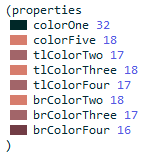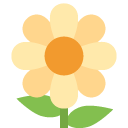King’s Quest VI is particularly interesting in that the window frame looks like it has eight parts — four edges, four corners — but the actual view only has the corners. Compared to the simple lines of KQ5, those thick wooden beams have to be views, right?
![]() But as you can see, they’re not in there.
But as you can see, they’re not in there.
So how is that woody frame drawn then? The answer: they totally are lines.
(class Kq6Window of SysWindow (properties colorOne 32 colorFive 18 tlColorTwo 17 tlColorThree 18 tlColorFour 17 brColorTwo 18 brColorThree 17 brColorFour 16 )
We interrupt this programming to give a bit of visual aid. Here’s those color properties again, but with the actual colors next to them:

Maybe you can see how they fit together, from the preview on top of the post and the property names.
(method (open &tmp oldPort) ; The established setup (= screens VISUAL) (if (!= priority -1) (= screens (| screens PRIORITY))) ; Make room for the edges (= lsTop (- top 5)) (= lsLeft (- left 5)) (= lsRight (+ right 6)) (= lsBottom (+ bottom 6)) ; Set our custom style (= type 128) ; Always top priority (= priority 15) (super open:) ; Now we draw, on the whole screen. (= oldPort (GetPort)) (SetPort 0) ; Call the method shown below. (self drawEdgedWindow: screens) ; Add the corner pieces (DrawCel 930 0 0 (- left 5) (- top 5) -1) (DrawCel 930 0 1 (- left 5) (- bottom 1) -1) (DrawCel 930 0 2 (- right 1) (- top 5) -1) (DrawCel 930 0 3 (- right 1) (- bottom 1) -1) ; Show what we have wrought. (Graph grUPDATE_BOX lsTop lsLeft lsBottom lsRight 1) (SetPort oldPort) ) ; This is where the actual magic happens. (method (drawEdgedWindow screens &tmp line color) ; Fill in the window (Graph grFILL_BOX top left (+ bottom 1) (+ right 1) screens back priority) ; Draw the top and left edges first (for ((= line 1)) (< line 6) ((++ line)) (= color (switch line (1 colorOne) ; inside (2 tlColorTwo) ; dark (3 tlColorThree) ; light (4 tlColorFour) ; dark (5 colorFive) ; light ) ) ; Top edge (Graph grDRAW_LINE (- top line) (- left line) (- top line) (+ right line) color priority -1) ; Left edge (Graph grDRAW_LINE (- top line) (- left line) (+ bottom line) (- left line) color priority -1) ) ; Draw the bottom and right edges (for ((= line 1)) (< line 6) ((++ line)) (= color (switch line (1 colorOne) ; inside (2 brColorTwo) ; light (3 brColorThree) ; dark (4 brColorFour) ; very dark (5 colorFive) ; light ) ) ; Bottom edge (Graph grDRAW_LINE (+ bottom line) (- left line) (+ bottom line) (+ right line) color priority -1) ; Right edge (Graph grDRAW_LINE (- top line) (+ right line) (+ bottom line) (+ right line) color priority -1) ) ) )
Those switch blocks could’ve been left out if they used, say, an array with the color values, but this way they can be exposed as properties. You win some, you lose some.
The drop cap is another story altogether.








